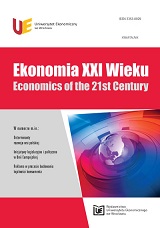Reklama w procesie budowania lojalności konsumenta: ujęcie modelowe
Advertising in the process of building consumer loyalty: a model approach
Author(s): Anna KozłowskaSubject(s): Economy
Published by: Wydawnictwo Uniwersytetu Ekonomicznego we Wrocławiu
Keywords: consumer; loyalty; advertising
Summary/Abstract: the aim of the article is to develop a new conceptual framework for examining the role of advertising in forming consumer attitudes. The author assumes that consumer attitudes mediate the process of making the decision to purchase a product. Existing advertising models are not sufficient for understanding the impact of advertising on a consumer. The identification of factors mediating in this interaction, such as the level of commitment to purchase (High-Mid-Low), the motive of purchase (cognitive-emotional) allow for the identification of at least nine different advertising strategies. The author presents her own concept of how advertising builds interest in the product mediating conceptual approach to the creation of the product, possibly contributing to the experience of the test (e.g. test drive car) and, consequently inducing the purchasing decision. It also shows that, depending on the product category, an ad after purchase (and experience with the product) reinforces the sense of fairness and the selection of the product and/or reminds of the existence of the brand on the market. The informative advertising (1) is for products that generate a high level of risk purchasing: such as white goods (refrigerators, washing machines and dishwashers), expensive electronic appliances (microwave ovens) and financial services (loans, mortgages, investment policies). Advertising should first of all make a demonstration of the basic features of the product. In case of advertising reducing the risk of purchasing (2), referring to such products as cars and some financial services, advertising will be primarily urged to trial experience or argued that the purchasing process is easy, simple and enjoyable. Advertising reducing emotional distortion (3) will highlight the fact that the purchase of a luxury version of the product (eg. clothing or cosmetics) offers greater guarantees to meet the needs (in line with the higher price − higher quality). At the same time advertising should emphasize the emotional reasons to purchase. It is different in case of the ad reducing information overload (4), where brand appeal should be built either by brand awareness (due to increased exposure) or by highlighting the specific attributes of this brand. Advertising building repeated behavior (5), relies primarily on the rational benefits, but providing specific knowledge about these products is not necessary in this case. In advertising building the routine behavior (6), and referring to such products as water, food, everyday use cosmetics, emotional charge quality, health, as well as a striking impression emotional arguments, such as shiny hair are more important. In case of advertising building the impulse behavior (7), it is vital to pay attention to the information about the possible immediate satisfaction from the use of the product. In an ad building the membership of the group (8), we find such products as coffee, soft drinks and beer. Y
Journal: Ekonomia XXI Wieku
- Issue Year: 2014
- Issue No: 01
- Page Range: 168-184
- Page Count: 17
- Language: Polish

